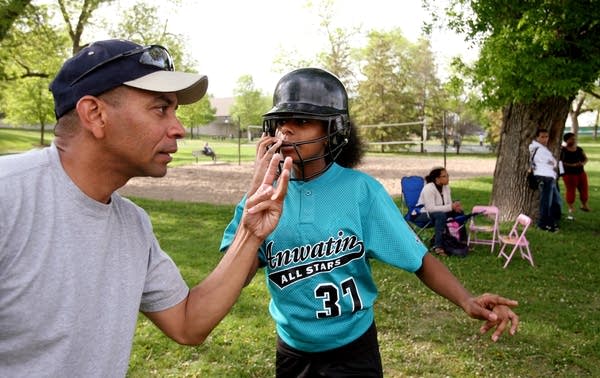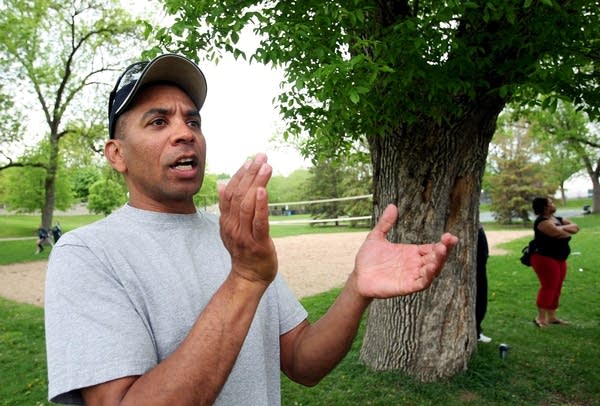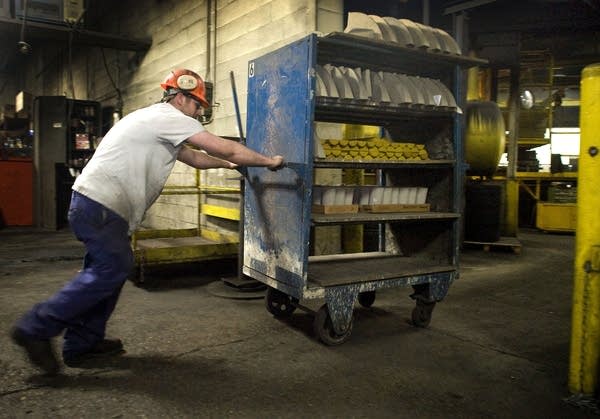Minnesota's jobs forecast: Living with higher unemployment

Mahdee Abdullah has been sitting on the sidelines a lot lately, at his 12 year-old daughter's softball games -- and in the economic recovery.
With no demand for his skills as a cement finisher, his daughter's games help fill the big void in his schedule.
"I'm coming to a lot of softball games, and that's a good thing to be able to spend with your kids," said Abdullah, of St. Paul.
Lately, Abdullah hasn't had any hits on the job front. The 35W bridge reconstruction provided his last opportunity for pouring concrete. He was laid off when the project ended a year and a half ago.
Create a More Connected Minnesota
MPR News is your trusted resource for the news you need. With your support, MPR News brings accessible, courageous journalism and authentic conversation to everyone - free of paywalls and barriers. Your gift makes a difference.
Since then, he's been getting by on unemployment insurance, but it's a pittance compared to the $50,000 a year he used to earn. His previous income allowed him to live comfortably, raise four children, support one in college, and travel from time to time.
At 45, Abdullah is looking for jobs outside his field and bracing for a lower wage. He doubts his next job will be in the area for which he spent years apprenticing and then worked for 10 years.
"Right now I'm not feeling too confident," he said. "It could be where you have to relocate or something like that. Even with that, you just don't have the money. So you're really in a catch 22. It's a tough thing. I just pray and hope that something will come along."

Abdullah is part of a big group of people who probably wish they had nothing in common -- the roughly 213,844 unemployed Minnesotans. They're the faces of the state's 7.2 percent jobless rate.
As an African-American man, he also belongs to two other groups that have higher jobless rates. A greater percentage of men are unemployed since so many male workers were in hard hit industries such as construction and manufacturing.
In 2009, the annual average unemployment rate for black men in Minnesota was about 22 percent, accordingto the Bureau of Labor Statistics. That compares to an annual average of 7.8 percent for the overall population last year.
Minnesota's unemployment rate has fallen from a year ago, when it reached its peak for this recession. But despite the drop, economists say it will take a long while to reach the low levels the state has enjoyed.
"Even by 2014 and 2015, the unemployment rate is going to seem high compared to the historical normals," Minnesota state economist Tom Stinson said.
He said the jobless rate will fall over the next five years, to 4 or 4.5 percent.
"That's still more than we're used to," Stinson said. "We had a long period when we were down in the threes."
But the jobs recovery could be bumpy.

One of the perverse things that happens when an economy rebounds and jobs sprout is that the unemployment rate can climb. That's because of people who gave up on finding a job during the recession.
A person who no longer is looking for work is not counted as unemployed, said Heidi Shierholz, a labor economist at the Economic Policy Institute, a Washington think tank.
When things start to pick up and that person starts looking for a job, they will enter the labor force as an unemployed person, Shierholz said.
But the economy may not pick up enough for all those unemployed people to find new jobs. That's because two trends coming out of the recession are likely to put a brake on the economy: consumer spending is weaker than normal and lenders are more cautious with credit.
"Growth in the economy is not going to be fast enough to generate healthy jobs growth," Shierholz said.
At United Machine & Foundry Corp. in Winona, company president Tom Renk didn't cut jobs in the recession. But as the economy improves and his business picks up, he also doesn't plan to add any jobs.
"Our intention is maintain the existing workforce and just increase productivity is what we want to strive to achieve," he said.

Renk wants to automate more of the work by installing machines that require fewer workers to operate them.
His workforce will likely thin out on its own. Many of his workers are nearing retirement age. That includes Randy Johnson, who has worked at the foundry for 30 years. He's grey-haired with slumped shoulders but darts around quickly, filling buckets with heavy sand.
"I don't know if we even had a forklift when I first started -- just a couple wheelbarrows and a bobcat," said Johnson, who is in his late 50s. "We've come a long way."
Renk said Johnson is typical of many factory workers.
"This particular industry has had a rap for quite a while for having an aging workforce," said Renk.
Thousands of other aging workers across Minnesota will be leaving the workforce in the coming years. And that exodus will have a profound effect on the job market.
The massive change looming traces back to the end of World War II. That was the start of the baby boom generation, the millions of people born from 1946-1964. Its members begin turning 65 next year. Boomer retirements will create millions of job vacancies around the nation in the next few years.

By 2018 those so-called replacement jobs will outnumber new jobs by a ratio of 2 to 1, according to U.S. Bureau of Labor Statistics estimates.
Steve Hine, the state's chief labor market analyst, says the upcoming wave of retirements is just one part of major demographic changes coming.
"Many more people are going to be leaving the labor force at the retirement end of the pipeline, and far fewer are going to be entering it through the graduate pipeline at the young end of the age distribution," Hine said.
According to state projections, Minnesota's labor force will virtually stop growing in a decade. Minnesota will add a mere 16,000 new workers to the labor market. That's only one tenth of the growth of the past 5 years.
Hine said boomers are already starting to retire and the labor force is growing at a slower rate. He thinks those forces will put downward pressure on Minnesota's jobless rate in four or five years.
"We may be surprised at how quickly the unemployment rate does begin to fall when those demographic changes really start to play out," Hine said.
Tom Stinson, the state economist, agrees, with some caveats. He said robust growth of new jobs -- not just replacement jobs -- is needed to pull the unemployment rate back down to the three-percent range the state once enjoyed.

"The increase in the number of people retiring will drive the unemployment rate down, but I'm not convinced it'll drive it down to the low levels we saw in the 90's," Stinson said.
No matter how much demographic changes end up benefiting the economy and lowering the jobless rate in the next few years, over the long term those changes will create big problems. In 10 or 15 years, so many baby boomers will retire and so few young workers will be available, economists say there may actually be a labor shortage that crimps American prosperity.
That may be hard to imagine now, with millions of workers out of jobs. But Hine, Stinson, and state demographer Tom Gillaspy all view this potential worker shortage as a real crisis facing Minnesota -- and the nation.
Gillaspy calls it the new normal, where fewer people will be working and creating wealth.
"The new normal is in the long run, over the next quarter century, half century, slower economic growth," Gillaspy said.
That will pinch everyone's standard of living -- as well as the resources state government will have to provide services.
In the end, it's these long-term demographic trends that economists worry about -- more so than the immediate effects of the recession and the high unemployment rate.
But the worker shortage is far enough in the future that it's unlikely to help unemployed people like Mahdee Abdullah any time soon.

For his part, Abdullah will be watching for the unemployment rate to reach healthier levels.
"It means a lot," he said. "Because that's what's going to dictate what will happen for me."
But the near-term outlook for construction workers like Abdullah is not bright.
Coming tomorrow: Thousands of lost jobs in hard-hit industries such as construction and manufacturing never will return. That will force many workers to find jobs in other fields or the service industry.

